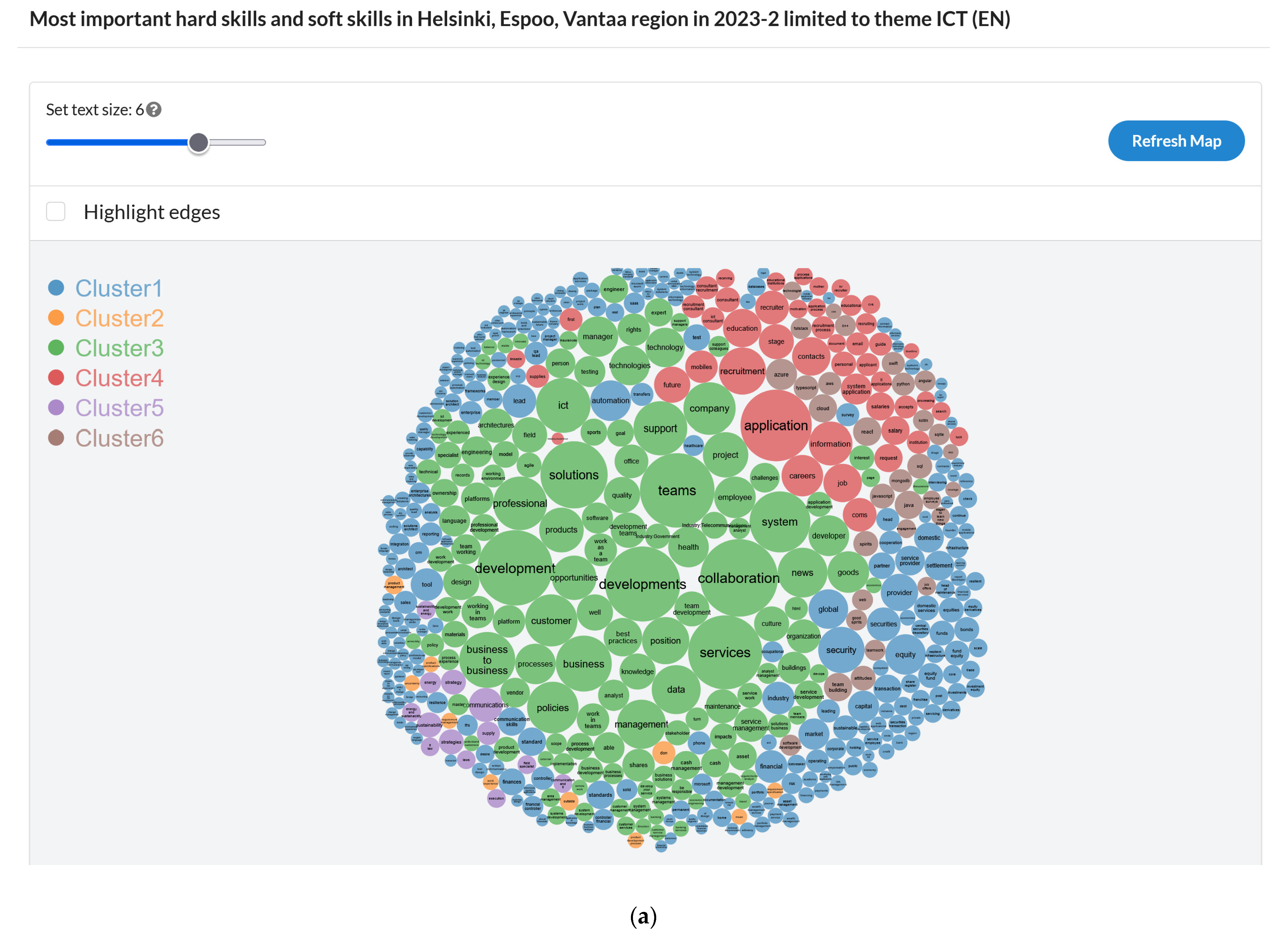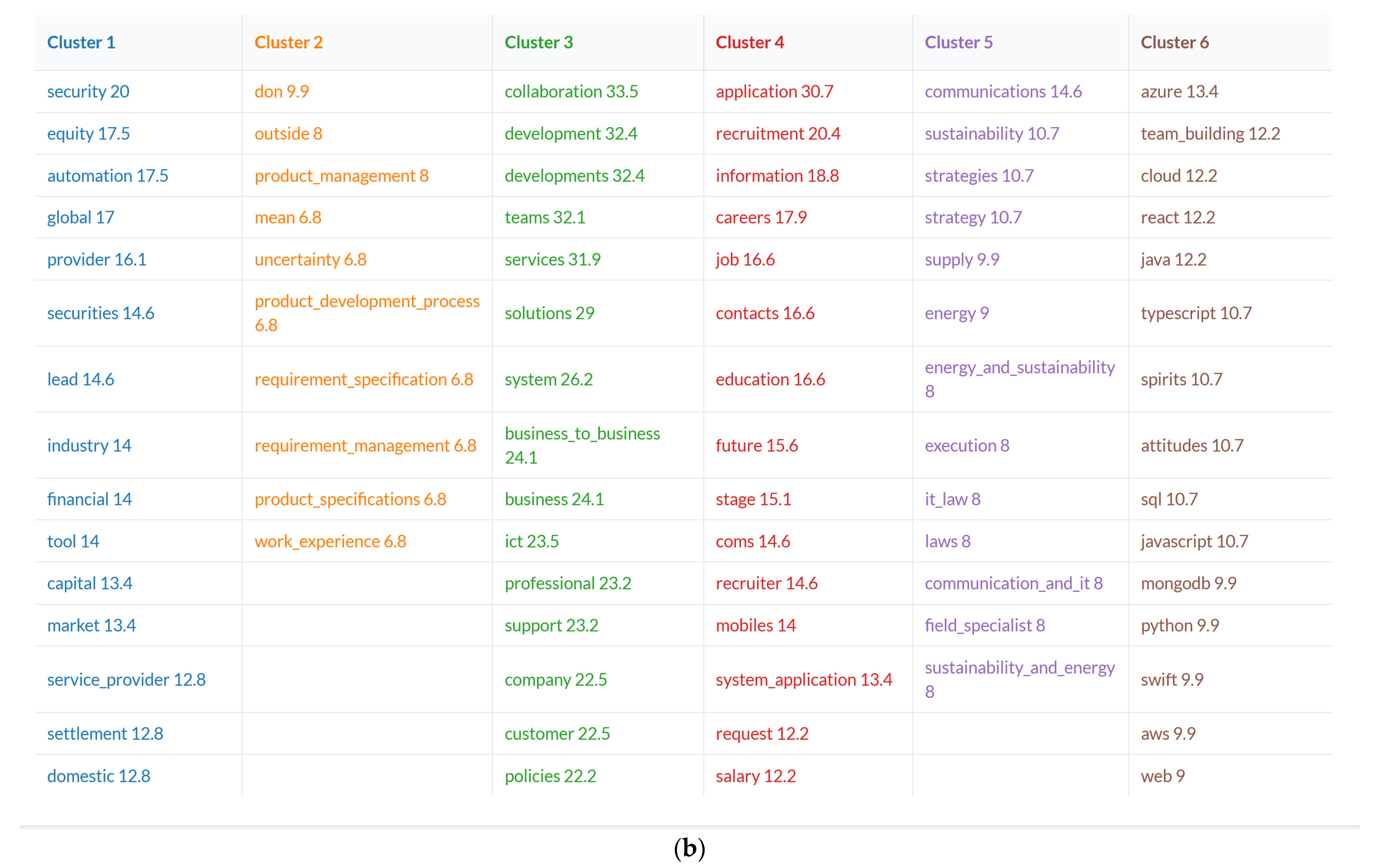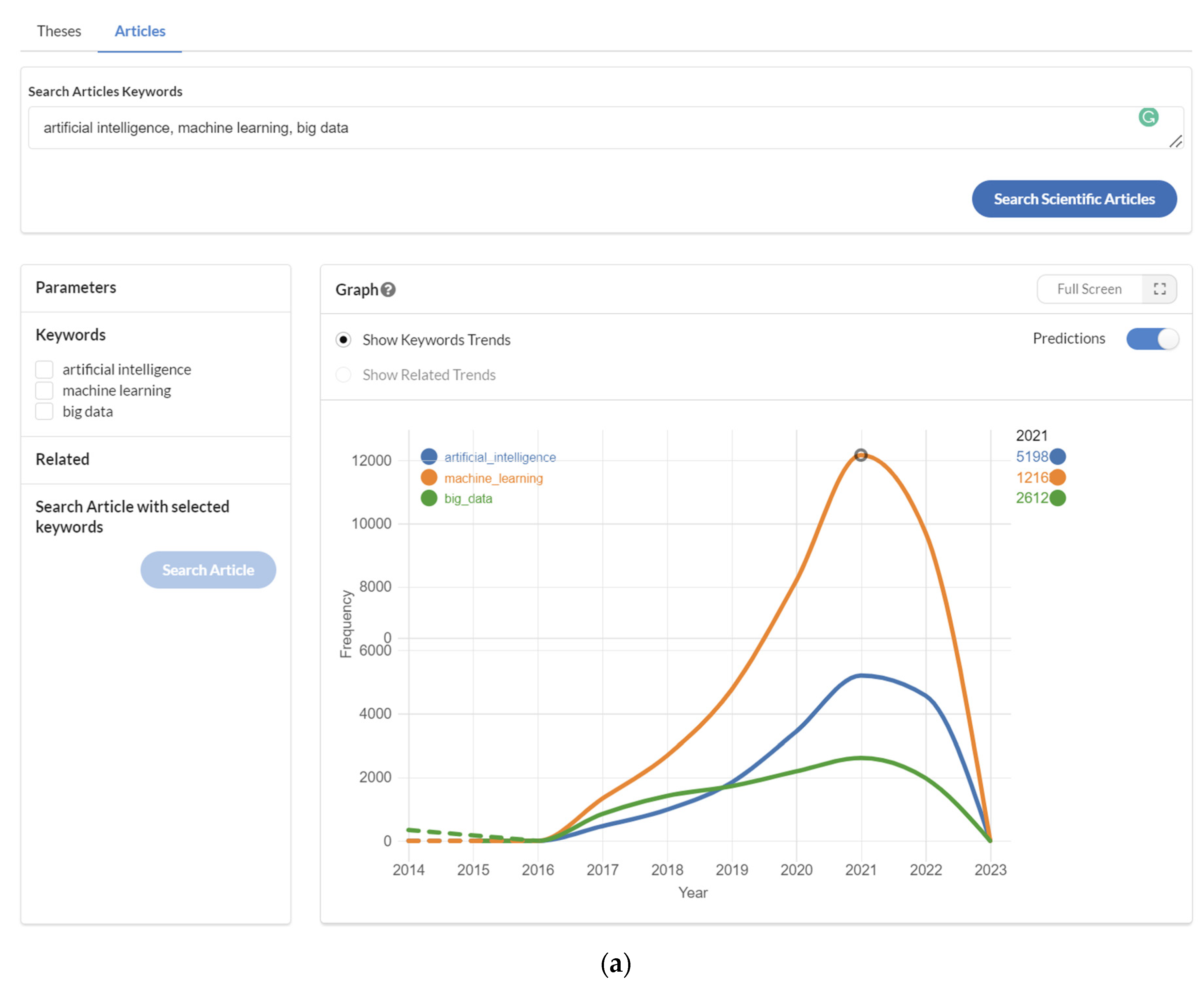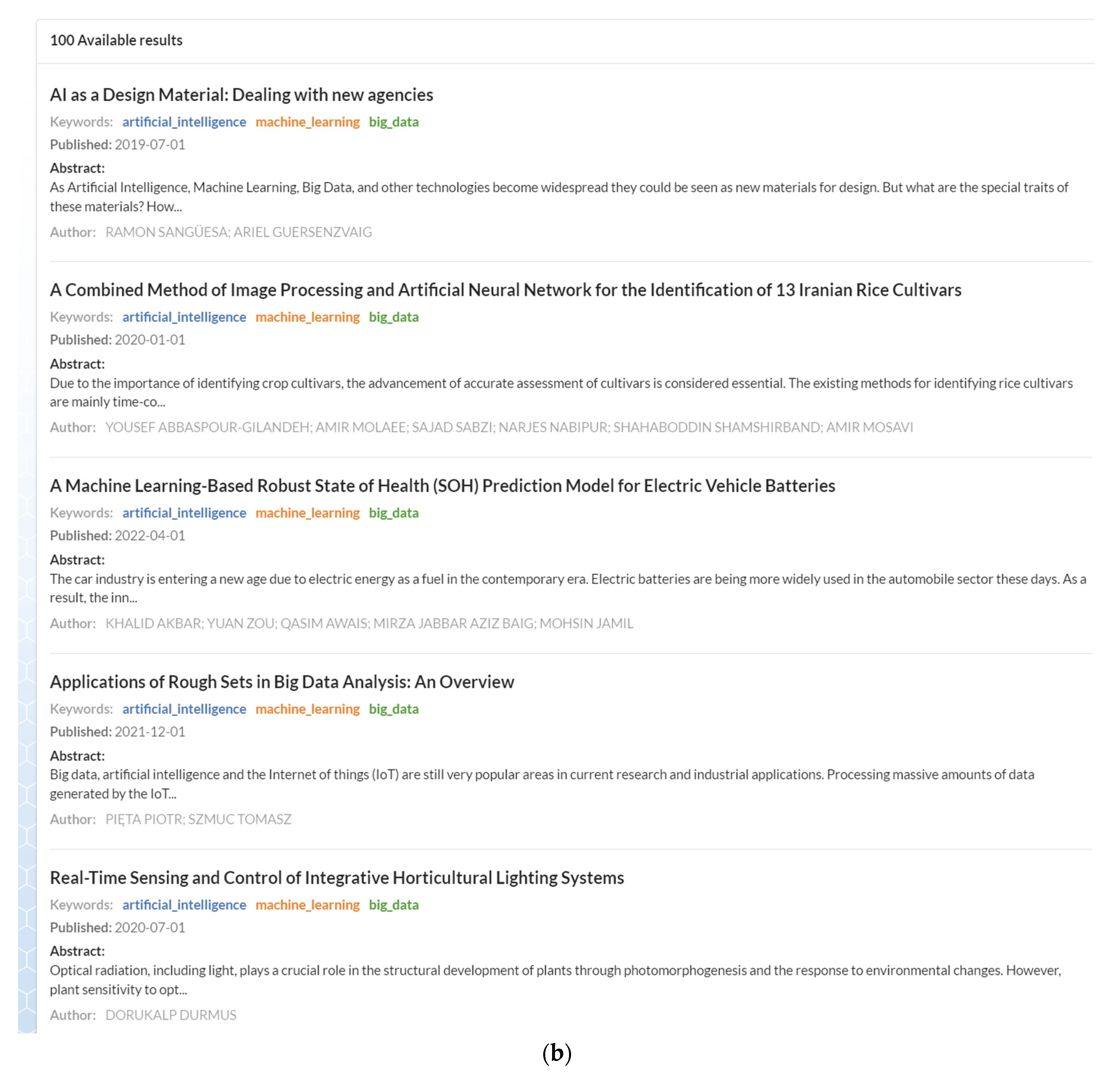Forecasted Self: AI-Based Careerbot-Service Helping Students with Job Market Dynamics †
Abstract
:1. Introduction
2. Background of Careerbot-Service of 3AMK in Finland
- (1)
- Verbalize their skills with the help of AI (skills profile; current or “forecasted self” in the future);
- (2)
- Find jobs with their skills profiles (job market intelligence);
- (3)
- Find courses for skill development (upskilling, re-skilling);
- (4)
- Find theses/research topics, trends, and content (research intelligence).
- (a)
- Job market data in Finland (Työmarkkinatori, MOL, and Duunitori/employment services) with more than 400,000 job ads on a yearly basis, since January 2018;
- (b)
- 3AMK course data for all 15,000 courses;
- (c)
- Theseus—A thesis database with more than 120,000 theses available from Finland, since 2010;
- (d)
- Global article database, a directory of open access journals, DOAJ, with more than 8.6 million articles.
- (i)
- Building a digital twin (personal, curriculum, and scenarios);
- (ii)
- Comparing two digital twins against each other to show similarities and gaps;
- (iii)
- Recommending interventions from the third digital twin to bridge the gap.
3. Conclusions
Author Contributions
Funding
Institutional Review Board Statement
Informed Consent Statement
Data Availability Statement
Conflicts of Interest
References
- Technology Industries of Finland. Skills Data Playbook. 2022. Available online: https://teknologiateollisuus.fi/sites/default/files/inline-files/Osaamisdatan-Playbook--ENG-03-aukeamittain.pdf (accessed on 23 March 2023).
- Mononen, A.; Alamäki, A.; Kauttonen, J.; Klemetti, A.; Räsänen, E. Adopting AI-enhanced chat for personalising student services in higher education. In Proceedings of the AINL 2020 Artificial Intelligence and Natural Language Conference, Online, 5–7 July 2020. [Google Scholar]
- Popenici, S.A.; Kerr, S. Exploring the impact of artificial intelligence on teaching and learning in higher education. Res. Pract. Technol. Enhanc. Learn. 2017, 12, 10–11. [Google Scholar] [CrossRef] [PubMed]
- Renz, A.; Krishnaraja, S.; Gronau, E. Demystification of artificial intelligence in education–How much AI is really in the educational technology? Int. J. Learn. Anal. Artif. Intell. Educ. (Ijai) 2020, 2, 4–30. [Google Scholar] [CrossRef]
- Chassignol, M.; Khoroshavin, A.; Klimova, A.; Bilyatdinova, A. Artificial intelligence trends in education: A narrative overview. Procedia Comput. Sci. 2018, 136, 16–24. [Google Scholar] [CrossRef]
- Tiihonen, J.; Felfernig, A. An introduction to personalization and mass customization. J. Intell. Inf. Syst. 2017, 49, 1–7. [Google Scholar] [CrossRef]
- Costa, E.B.; Fonseca, B.; Santana, M.A.; de Araújo, F.F.; Rego, J. Evaluating the effectiveness of educational data mining techniques for early prediction of students’ academic failure in introductory programming courses. Comput. Hum. Behav. 2017, 73, 247–256. [Google Scholar] [CrossRef]
- Ketamo, H.; Moisio, A.; Passi-Rauste, A.; Alamäki, A. Mapping the future curriculum: Adopting artificial intelligence and analytics in forecasting competence needs. In Proceedings of the 10th European Conference on Intangibles and Intellectual Capital ECIIC 2019, Chieti-Pescara, Italy, 23–24 May 2019; Sargiacom, M., Ed.; pp. 144–153. [Google Scholar]
- Yang, F.; Li, F.W. Study on student performance estimation, student progress analysis, and student potential prediction based on data mining. Comput. Educ. 2018, 123, 97–108. [Google Scholar] [CrossRef]
- Clauset, A.; Newman, M.E.; Moore, C. Finding community structure in very large networks. Phys. Rev. E 2004, 70, 066111. [Google Scholar] [CrossRef] [PubMed]
- Unser, M.; Aldroubi, A.; Eden, M. On the asymptotic convergence of B-spline wavelets to Gabor functions. IEEE Trans. Inf. Theory 1992, 38, 864–872. [Google Scholar] [CrossRef]




Disclaimer/Publisher’s Note: The statements, opinions and data contained in all publications are solely those of the individual author(s) and contributor(s) and not of MDPI and/or the editor(s). MDPI and/or the editor(s) disclaim responsibility for any injury to people or property resulting from any ideas, methods, instructions or products referred to in the content. |
© 2023 by the authors. Licensee MDPI, Basel, Switzerland. This article is an open access article distributed under the terms and conditions of the Creative Commons Attribution (CC BY) license (https://creativecommons.org/licenses/by/4.0/).
Share and Cite
Mononen, A.; Alamäki, A.; Kauttonen, J.; Klemetti, A.; Passi-Rauste, A.; Ketamo, H. Forecasted Self: AI-Based Careerbot-Service Helping Students with Job Market Dynamics. Eng. Proc. 2023, 39, 99. https://doi.org/10.3390/engproc2023039099
Mononen A, Alamäki A, Kauttonen J, Klemetti A, Passi-Rauste A, Ketamo H. Forecasted Self: AI-Based Careerbot-Service Helping Students with Job Market Dynamics. Engineering Proceedings. 2023; 39(1):99. https://doi.org/10.3390/engproc2023039099
Chicago/Turabian StyleMononen, Asko, Ari Alamäki, Janne Kauttonen, Aarne Klemetti, Anu Passi-Rauste, and Harri Ketamo. 2023. "Forecasted Self: AI-Based Careerbot-Service Helping Students with Job Market Dynamics" Engineering Proceedings 39, no. 1: 99. https://doi.org/10.3390/engproc2023039099
APA StyleMononen, A., Alamäki, A., Kauttonen, J., Klemetti, A., Passi-Rauste, A., & Ketamo, H. (2023). Forecasted Self: AI-Based Careerbot-Service Helping Students with Job Market Dynamics. Engineering Proceedings, 39(1), 99. https://doi.org/10.3390/engproc2023039099





